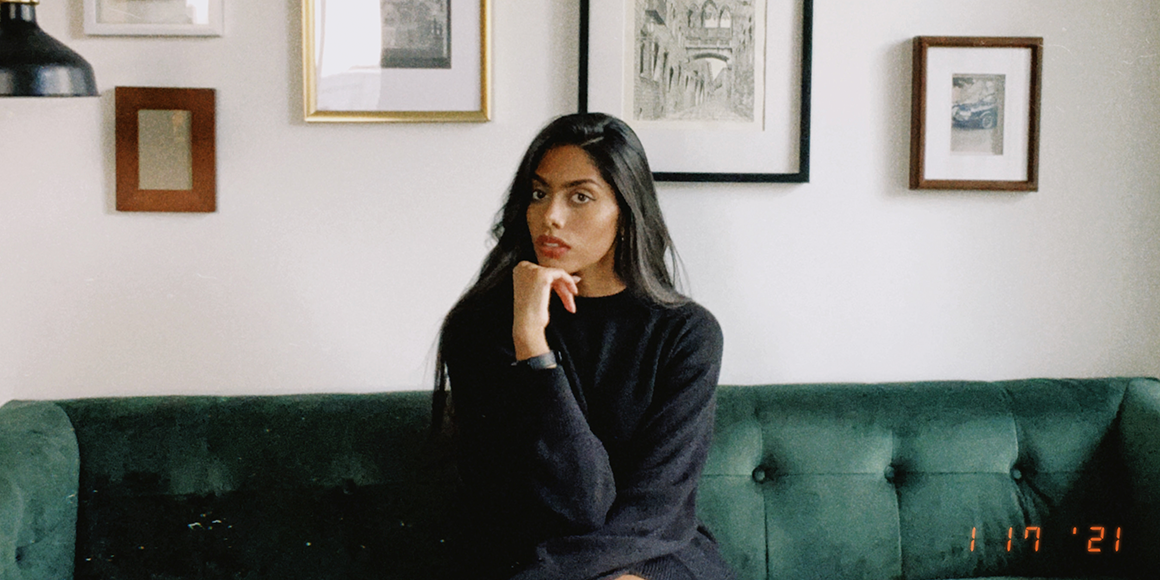Most kids of Asian immigrant parents know that a career in the arts is off limits. After all, it’s not the safest or most direct route to stability. But that didn’t deter Pranavi Suthagar from ultimately chasing her dreams.
“I’ve always been interested in the arts and creative fields, but as the stereotype goes, I was never encouraged to pursue the arts. It was always labeled as a hobby by my family,” the Toronto-based illustrator and designer said.
Suthagar ended up going to business school first, but dropped out after her first year without telling her parents. “When I broke the news, they were super not happy about it,” she said. “But while I was at art school, I almost used the lack of support as motivation and fuel to break into my industry.”
The Mississauga, Ont.-native managed to start building her career while attending OCAD University in Toronto. That’s also when she launched her online store Not Sari, which focuses on highlighting the South Asian experience, and more specifically, the Tamil experience. “I thought I could use my skills as an illustrator and a designer to sort of animate that experience and connect with people because oftentimes our narratives are just pushed aside and not seen as the mainstream even though they’re 100 per cent valid,” she explained.
Suthagar knows what it’s like to face the stigma of pursuing a creative career. That’s why she partnered with her two friends — Mithushaa Berinpalingam and Sonia Dheer — to launch Parvai this year. Parvai a six-week program aimed at women and non-binary South Asian youth to help them grow and explore creative paths. “Because art is not just a hobby,” Parvai’s website reads.
Speaking to The RepresentASIAN Project, Suthagar dives into the challenges of being Tamil-Canadian, the importance of highlighting her culture in her work, and how Parvai is empowering young South Asians to pursue creative careers.

On growing up without South Asian representation
I feel like every Tamil person’s default role model is M.I.A. because she’s the only [prominent] Tamil person — her or Mindy Kaling. I definitely admire them and where they got to, but I feel like I was more inspired by a lot of Black artists and Black women, like Issa Rae. I don’t think it’s always about seeing yourself and the ethnicity, but it’s about the person’s values and how they interact in society. But I wouldn’t say [having a lack of representation] didn’t bother me. I just found other avenues and other people to look up to.
I don’t think there’s necessarily [a need] to have one role model that looks like you, but [what’s terrible is] the fact that you watch any TV show and you won’t see a single brown person unless they’re the convenience store worker or the taxi driver. And especially being Tamil, you’re in an even smaller niche where everyone thinks you’re Indian, but you’re [not], and there’s a whole lot of history behind that identity, especially because of the Tamil Eelam War. Our identity is so complex that even seeing an artist like M.I.A. is very impactful because she’s from that exact background. But I think not seeing anyone that looks like you impacts you more than only having one or two role models.
Even in South Asian [media], like Bollywood or Kollywood, [there was a lack of representation because] they cast light-skinned Indian people typically, even in movies made for Tamil people. I feel like when you don’t see yourself, you almost can’t picture yourself in certain positions, especially in the media and in the art world. Even in OCAD, for example, when we did the art history course, we spent so many weeks focused on European arts and going deep into the Renaissance era. And then the Asian sector of art was condensed into, I think, maybe two classes. So it’s hard to describe, but it’s just the minimizing of your identity, which impacts you. It’s like, I want to learn more but I can’t because the resources aren’t given to me.
I feel like when you don’t see yourself, you almost can’t picture yourself in certain positions, especially in the media and in the art world.
On the challenges of being Tamil-Canadian and learning about her cultural roots
I’ve struggled with: how do I express my identity? It almost feels like at home, that’s where you’re your whole Tamil self and then at school or in society, you’re just the westernized version of yourself because there isn’t really room to express yourself [or] space created to do that. So you’re just kind of balancing two identities. I don’t think it’s super conscious when you’re in it, but I think in reflection you see it a lot more.
[I learned about my Tamil culture] through family, parents, and community, but I also felt like I had to go out of my way [to learn about it]. For instance, I keep circling back to the Tamil Eelam War, which had a significant impact and is the reason why some people are actually not living in Sri Lanka and why a lot of people call themselves Tamil versus Sri Lankan. For me, that was something that wasn’t talked about openly because there’s still fear in a lot of Tamil people to speak on that because of the way the government is back home, essentially. So I had to learn that when I was in university, and now I go out of my way to learn that really dark side of the history because it’s a part of my identity. I definitely feel like I [grew] into my identity and I came to understand and learn about it more as I got older.
On how she wants her work to be perceived as a Tamil artist
I think my experience as a Tamil-Canadian is really reflective of a lot of South Asian communities — not that it’s a direct reflection, but I think a lot of South Asian folks can relate because we grew up with really similar cultural norms. But my work is evolving from when I started in 2017 to [being] less focused on my Tamil identity, per se, and more about me as a Tamil artist just creating work. I want to continue to push that [so] my work can just be normal. My work is not Tamil work, it’s just made by a Tamil person. I want my work to lean more into that realm where people don’t need to be like, “Oh yeah, that’s the brown artist” because I feel like that’s still pigeonholing. Of course I’ll always have themes where I use myself or people I know as a subject and it’s inherently highlighting the Tamil experience, but I want to evolve to a point where my work can just exist and we don’t have to call it a specific name relating to my background.
“When people say they feel so seen by my work, that gives me so much purpose in why I create.”
[That said,] I’m not afraid to add Tamil motifs or write in Tamil on my pieces and stuff like that because as much as I want to just be seen as an artist and not my ethnicity, I still think it’s really important to continue to create work that represents us. When people say they feel so seen by my work, that gives me so much purpose in why I create.
On why she’s so passionate about launching Parvai to empower South Asian youth
This is a dream project, essentially. My friends [and I] wanted to create Parvai because we know there is a common rhetoric among South Asian people — and I’m sure all Asian people — that we have to first pursue the safe path, and if you want to pursue your passions, you do it on the side. So Parvai’s all about [turning your] hobby into your career, if that’s what you want.
[Our parents aren’t] saying, “Don’t pursue art because we don’t like art.” It’s because it’s this unknown, unsafe path and they want to make sure we’re on a safe route to stability. So with the program, we’re helping to guide [underserved South Asian youth] into different paths, which is not just creatively focused, but also through self-development, budgeting, [and] understanding different elements of life.
The problem with coming into the creative industry is that there’s a lot of resources that are openly available, but you need to know where to look. And if you just think, oh, I want to be an artist, that’s a very broad idea. We need to create paths and make actual plans to get there. So we’re trying to set [youth] up with really tangible ways to access these creative paths, feel confident, and be able to go home and tell their parents, “Listen, I want to do this, but I have a plan and I have these grant opportunities, public opportunities, resume building skills where I can find myself employment…” [We’re trying to create] a route versus having just an arbitrary goal that is difficult to approach.
The long-term vision is to [run the program] once a year, at least. We also want to have an alumni program [so] we’re not just doing this workshop series and then [saying] bye. We want to make sure [they’re] on a path and [set up with] places they can go to further enhance their creative practice. So that’s the goal.
On how her parents feel about her career in the arts now
I feel like [my parents have] really come around to understand the choices I’ve made, and I think they are proud for sure. In our culture, we don’t really get the “I’m proud of you,” but they know I’m stable, I’m happy, and I’m always trying to grow, so I think they’re really happy to see where I’m at. At the end of the day, I think parents evolve as they see their kids grow up and see that they don’t need to be a parent forever. So as much as it is a process for us to break out of cultural norms, it’s also a process for them to understand that.
Since I went to OCAD, my goal was to get a job as soon as possible in my field because I felt like I needed to make it. And to be frank, I still feel that pressure of needing to make it, but I’m trying to really acknowledge my wins, be more present and grounded in the moment, and then just take each day by day, as cheesy as that is. I feel like for a lot of us [immigrant kids], we’re raised with that mentality of “you gotta be successful,” especially seeing your parents struggle and work so hard for you to have what you have. So I feel like that’s really ingrained in me, but I’m trying to take steps to make that not a source of anxiety, but a source of inspiration.
Like this post? Follow The RepresentASIAN Project on Instagram, TikTok and YouTube to keep updated on the latest content.











